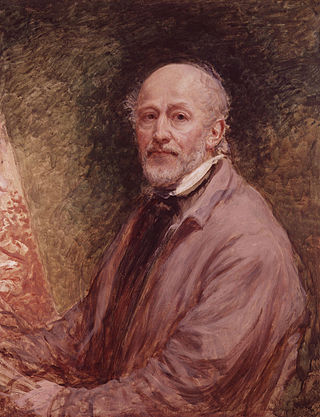
A gravel pit is an open-pit mine for the extraction of gravel.

John Linnell was an English engraver, and portrait and landscape painter. He was a naturalist and a rival to the artist John Constable. He had a taste for Northern European art of the Renaissance, particularly Albrecht Dürer. He also associated with the amateur artist Edward Thomas Daniell, and with William Blake, to whom he introduced the painter and writer Samuel Palmer and others of the Ancients.

William Horsley was an English composer, organist and teacher.

John Callcott Horsley was a British academic painter of genre and historical scenes, illustrator, and designer of the first Christmas card. He was a member of the artist's colony in Cranbrook.

Sir Augustus Wall Callcott was an English landscape painter.

Maria Graham, Lady Callcott, was a British writer of travel books and children's books, and also an accomplished illustrator.
Charles Edward Horsley, English musician, was the son of William Horsley, and the grandson of John Wall Callcott. Horsley was depicted as the composer Auchester in Elizabeth Sara Sheppard's novel Charles Auchester (1853).

Notting Hill Gate is one of the main thoroughfares in the Royal Borough of Kensington and Chelsea. Historically the street was a location for toll gates, from which it derives its modern name.

John Wall Callcott was an English composer.

Albany Street is a road in London running from Marylebone Road to Gloucester Gate following the east side of Regent's Park. It is about three-quarters of a mile in length.

Meard Street is a street in Soho, London. It runs roughly east–west, between Wardour Street to the west and Dean Street to the east. It is in two sections, with a slight bend in the middle: the west half is pedestrianised, while the east half is a narrow, single-lane road.

St Mary Abbots is a church located on Kensington High Street and the corner of Kensington Church Street in London W8.

Double Arches Pit was a sand quarry near the village and civil parish of Heath and Reach, Bedfordshire, England. It is now a Site of Special Scientific Interest and a Geological Conservation Review site.

Essex Street Chapel, also known as Essex Church, is a Unitarian place of worship in London. It was the first church in England set up with this doctrine, and was established when Dissenters still faced legal threat. As the birthplace of British Unitarianism, Essex Street has particularly been associated with social reformers and theologians. The congregation moved west in the 19th century, allowing the building to be turned into the headquarters for the British and Foreign Unitarian Association and the Sunday School Association. These evolved into the General Assembly of Unitarian and Free Christian Churches, the umbrella organisation for British Unitarianism, which is still based on the same site, in an office building called Essex Hall. This article deals with the buildings, the history, and the current church, based in Kensington.
The Gravel Pit Chapel was established in 1715–1716 in Hackney, then just outside London, for a Nonconformist congregation, which by the early 19th century began to identify itself as Unitarian. In 1809 the congregation moved to the New Gravel Pit Chapel nearby, while its old premises were taken over by Congregationalists. The New Gravel Pit Chapel was closed and demolished in1969.

Bedford Gardens is a street in Kensington, London. It runs west–east from Campden Hill Road to Kensington Church Street.
William Hutchins Callcott was an English organist, composer and arranger of music.

Porchester Terrace is a street in the Bayswater area of London. Located in the City of Westminster, it runs between Porchester Gardens in the north and the Bayswater Road to the south close to Kensington Gardens. Adjacent streets Leinster Gardens and Queensborough Terrace run directly parallel to it, as does Queensway a little to the west. At the northern end is the Hallfield Estate.

Kensington Gravel Pits is an 1812 landscape painting by the British artist John Linnell.
Rosamund Brunel Gotch was an English stage costume designer, illustrator and writer.
















